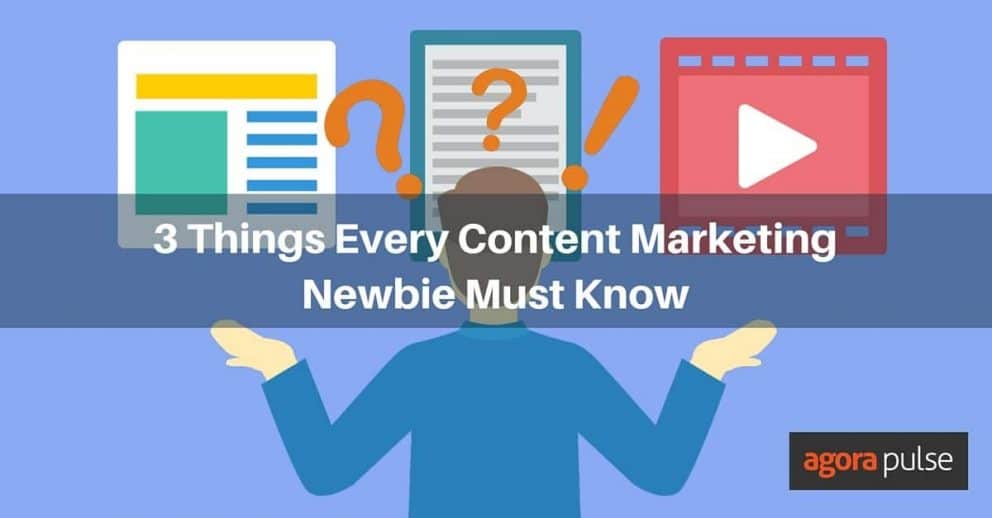Dear Content Marketing Newbie,
So you wanna be a content marketer? A writer of epic stuff? An inbound marketer who wears a cape and saves the day with your lead-capturing content?
I can’t blame you. With stats like …
- 76% of marketers are increasing investment in content marketing
- 64% of companies with a documented content strategy have a dedicated content marketing budget
- 26% of marketers are investing in content distribution
… a content marketing job is almost like sitting at the cool table in the high school lunchroom. Almost.
Nothing “cool” comes for free and even content marketing has a dark side.
Content shock (the theory that Americans have nearly reached their limit with how much content they’re consuming) and the fact that social referral traffic is WAY down are just two signs that the road to wearing that cape is paved with hardships.
But don’t fret. We’ve got three pieces of content marketing newbie advice that will set the course for the cool table. 🙂
I, Content Marketing Newbie, Promise To Learn That …
Lesson One: Content marketing doesn’t start with content [shocker].
[Tweet “SHOCKER: content marketing doesn’t start with content.”]
I know. You’re all like, “What?!” And I’m nodding my head “yep” with a smirk on my face.
A lot of people get this one wrong. They start sending out all types of content and then wonder why their lead capture ratio sucks, or why no one is sharing their “epic” content.
There’s no secret sauce here. The key to creating seriously awesome content is knowing how your customers and would-be customers define seriously awesome content.
Think about the blogs and sites you follow (like Agorapulse!). You continue visiting those sites because they’re constantly sharing information that you NEED; information that will help you be a better content marketer/marketer/baker of delicious cookies.
Recipe sites are a good example because they’re giving you the step-by-step process of how to do something. Your content should do the same.
And how do you KNOW what step-by-step processes your audience needs? You define them. You define their needs, internal and external pressures, their pain points, and then …?
You solve them with an excellent and engaging “recipe.”
Sub-Lesson One: Giving your step-by-step processes for free is okay.
A lot of people balk at this one. “But, it took me time and money to develop that “recipe!” There’s NO WAY I’m giving that away for free!”
But as Jay Baer points out in his book Youtility, epic content marketing is creating content so valuable that people would pay for it.
And look at you, over here giving it away for free! You’re awesome! You must sit at the cool table!
When conducting your audience analysis, ask yourself these 10 questions:
- Who are my industry targets (who are — or would make — your best customers)?
- What are their job titles (get specific!)?
- What are their daily responsibilities?
- What are their biggest frustrations or pain points with that title and those responsibilities; what are some of their internal and external pressures?
- What products/services/etc. do they NEED; what [thing] could help solve their pain points?
- What do I/we do better than our competitors?
- What products/services/things do I/we have that can benefit this prospect the most?
- What will that product/service/thing do for the prospect; how will it/they relieve their pressures?
- What keywords best describe the group of prospects I’m trying to target?
- What keywords best describe the product/service/thing I’m trying to sell to my target audience?
Be honest. If you did the homework and asked all of those questions, came up with 3-5 groups of people you wanted to target with your content, and then wrote content specifically for those groups with plenty of step-by-step “recipes” and calls-to-action on that content that sold the product/service/thing that solved all of their problems, what do you think would happen?
Leads. Leads would happen. And someone might give you a cape.
Lesson Two: Quality content matters, but content distribution matters more.
Okay, you’ve got your audience figured out, you know what kind of content to create, you create that content and publish it on the blog and then …?
And then it sits there and no one reads it or shares it (except for maybe your mom) and you’re totally bummed.
You haven’t done anything wrong, but you haven’t really done much either.
As Mark Schaefer says in his book The Content Code, creating content isn’t the finish line, it’s the starting line (a must-read for any content marketing newbie!).
Enter content distribution.
Content distribution or promotion is the how you get your content SEEN; how you get it to move (get shared) across online channels.
[Tweet “Here are 7 ways you can “move” your content once it’s published …”]
- Social media
- Syndication platforms
- Advertising
- Influencer outreach
- Partnerships
- Press releases
So not only do you need to write that spot-on piece that’s crazy valuable to your target audience, you also need to ensure it gets its little butt out there to show off.
There are different theories and methods to creating your content distribution plan, but one of the most popular is the 80/20 Rule.
Lesson Three: Your content marketing efforts must tie to business goals and be measurable.
Here’s where we are now:
- We know our target audiences and what kinds of content they want. [check]
- We’ve written content that speaks directly to our audience’s pain points; we’ve solved their problems with our “recipes” and then asked them to connect with us or become a lead to learn more. [check]
- We’ve shared our “recipes” around the interwebs and have made sure that our evergreen pieces (the ones that never truly “expire”) are constantly getting shared online.
- We’ve used other (perhaps paid) methods to ensure our content is being seen by new (but targeted) leads.
We’ve done a lot. Give yourself a pat on the back and then take a breath, because we’re still not done.
Content marketing newbies can’t get that coveted cape unless their content is capturing leads, remember?
And the only way you can understand how and if that’s happening is if you’re measuring results.
I’ve got another book for you to read. It’s The Content Formula (Calculate the ROI of Content Marketing & Never Waste Money Again) by Michael Brenner and Liz Bedor.
Here are the 10 steps to develop your content formula (from the book):
- Google yourself
- Know your share of voice
- Identify the cost of creating content at your company
- Know the percentage of your website content that attracts your target audience
- Understand how much traffic your traditional marketing efforts send to your site
- Know your organic and paid traffic results
- Get acquainted with your subscriber list
- Know your cost per lead
- Identify the percentage of marketing-generated revenue that comes from content marketing
- What’s the lifetime value of your customers, and how many of those customers come from content marketing?
Those steps will help you create your own content marketing formula. And if that’s too difficult — I know, you’re just a content marketing newbie! — try measuring these four content marketing metrics.
Get Your Content Marketing Cape On
Who knew it was just a chore to sit at the cool table?!
Getting to, and staying at, the top of the food chain is hard.
Follow these three lessons and when you do, you’ll find it’s not as hard as you think to graduate from a content marketing newbie to a content marketing superhero.
If you have any lessons to add or questions to ask, give me a shout out in the comments section below!





